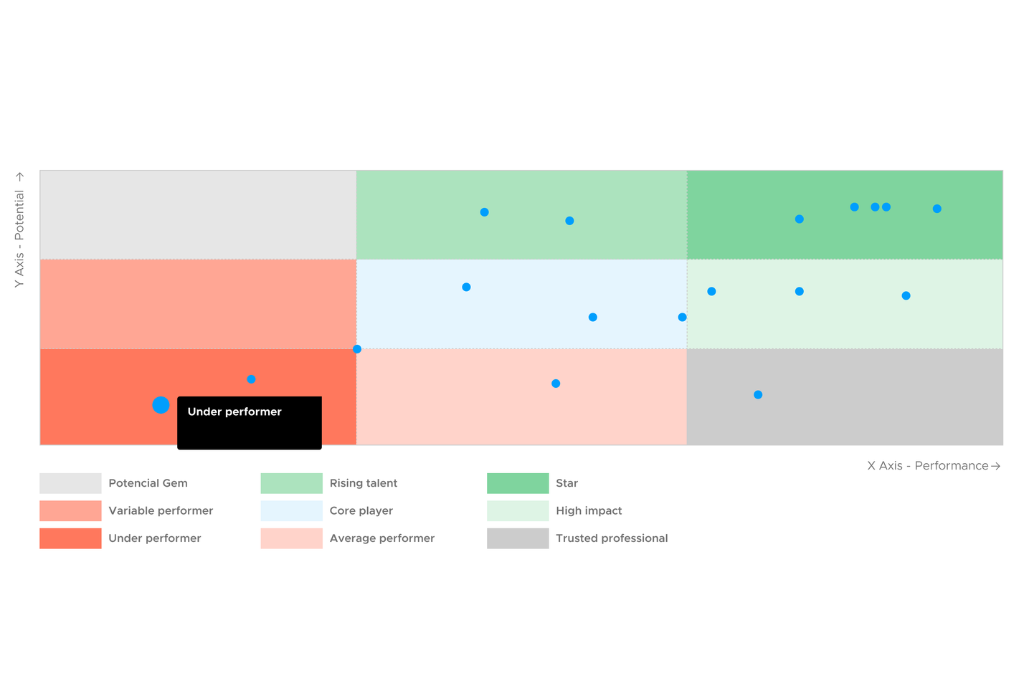Employee engagement plays a crucial role in the success of organizations. Needless to say, employees are the most valuable asset of any organization, and their well-being directly impacts the company’s bottom line. But, what is employee engagement?
Understanding and fostering employee engagement is vital to creating a thriving, high-performing workforce. You must be aware of the importance of improving employee engagement to achieve this. This will enable you to drive sustainable growth and competitive advantage for your company.
So, are you ready to find out what employee engagement is? Take a look at these best practices about employee engagement and soak up the info within this article to be part of the list of the top companies in employee engagement!
What is employee engagement?
In general, when we talk about employee engagement, we refer to the level of commitment, passion and dedication to their work and to the organization of employees.
Even though it seems obvious, it is worth pointing out that engaged employees are more motivated, productive and deeply connected to their roles. In fact, engaged employees are driven by a sense of purpose that, as it happens, is one of the most common drivers of company development and growth.
A good employee engagement culture promotes alignment between an employee’s personal values, goals, and aspirations with values of the organization. Not to mention how important it is to encourage remote employee engagement as part of a good engagement culture.
By nurturing employee engagement, organizations can cultivate a workforce that is deeply connected to the organization’s mission, committed to achieving shared goals, and empowered to drive sustainable success. You can do so by implementing employee engagement activities in your company, for example.
In short, the answer to the question “what is employee engagement” is very easy: the alignment between the values, objectives and culture of both the company and the employee.
5 Types of employee engagement
The relationship of employees with their work and organization is multifaceted and complex. This causes a number of 5 employee engagement types that address a specific aspect of this relationship.
If you’re wondering why this is important to know, here’s the answer. By recognizing and nurturing these different aspects, organizations can develop employee engagement strategies and practices that foster participation, personal growth and collective success.
So now that you know what employee engagement is and why there are different types, let us show you some of the types of employee engagement that exist through real examples.

Cognitive engagement
Cognitive engagement refers to the level of mental involvement that employees have to their work. Engaged employees demonstrate critical thinking skills, problem-solving abilities, and the capacity to generate innovative ideas that contribute to their role and the organization.
Let’s imagine an employee who works in the marketing department of a company. In every weekly meeting, this engaged employee discusses marketing strategies and finds creative solutions to achieve the established goals.
During these meetings, the employee brings innovative ideas and makes relevant questions to drive reflection and critical thinking. They also use their expertise and knowledge to analyze data, identify trends, and propose effective strategies.
Emotional engagement
Emotional engagement reflects the emotional connection employees develop towards their work, colleagues, and the organization as a whole. Engaged employees experience a sense of pride, enthusiasm, and dedication in their role, which leads to higher job satisfaction and commitment.
Let’s imagine a People professional who deeply cares about the well-being and development of the organization’s employees. In their daily work, the People professional actively listens to their concerns, needs, and aspirations, showing empathy and understanding.
The also provide a safe space for employees to express their worries and suggestions, fostering a climate of trust and openness.
Conductual engagement
Conductual engagement is all about the actions and behaviors that engaged employees demonstrate in the workplace. These employees go above and beyond their assigned task and take proactive steps to contribute to the success of the organization. They actively find opportunities to make a positive impact and drive meaningful outcomes.
Let’s imagine a sales department employee who demonstrates behavioral engagement in their daily performance. In their everyday work, this employee goes beyond assigned sales tasks and actively seeks opportunities to drive the company’s growth and profitability.
For instance, they organize additional cold calls, follow up with potential clients, and explore creative ways to generate new business opportunities.
Relational engagement
Relational engagement focuses on the creation of solid relationships within the workplace. Engaged employees actively invest time and effort in cultivating positive connections based on trust, respect, and open communication.
Imagine a project manager in the IT department in their daily interactions with colleagues and stakeholders. In team meetings, the project manager actively listens to team members’ ideas, concerns, and suggestions, creating a supportive and inclusive environment.
They encourage open dialogue, ensuring that everyone feels heard and respected. By fostering a positive and collaborative atmosphere, the project manager promotes effective teamwork and synergy among team members.
Developmental engagement
Developmental engagement highlights employees’ commitment to personal and professional growth. Engaged employees actively find opportunities for learning, skill development, and career advancement within the organization, benefiting both their individual growth and the organization’s progress.
Let’s consider an example of an employee in the operations department who exhibits developmental engagement. In their role, they actively seek out opportunities to enhance their knowledge of operational processes, systems, and technologies. Attend training sessions, workshops, and conferences related to operations management.
They also take the initiative to collaborate with colleagues, share best practices, and implement process improvements to streamline operations and increase productivity.
By embracing a developmental mindset, this employee not only enhances their individual capabilities but also contributes to the overall effectiveness and success of the operations department.
Employee engagement goals: 10 Examples you can measure
Employee engagement goals refer to specific objectives set by organizations to enhance and optimize the level of employee engagement within their workforce. It is crucial for these goals to adhere to the SMART rule, ensuring they are Specific, Measurable, Achievable, Relevant, and Time-bound.
The impact of well-defined employee engagement goals on the company is significant. Firstly, they provide a clear direction and focus, aligning employees’ efforts with the organization’s mission and vision. This fosters a sense of purpose and meaning in their work, leading to increased job satisfaction and productivity.
Keep in mind that these goals are specific and measurable to track progress and evaluate the effectiveness of the initiatives designed to improve employee engagement.
By setting specific and measurable goals, organizations can assess their impact, make data-driven decisions, and continuously refine strategies to enhance employee engagement.
There are many types of employee engagement goals, but here is a list of the most common ones. So pay close attention to the following examples and take a look at our article about measuring employee engagement.

1. Increasing employee productivity
Setting realistic goals to enhance productivity involves optimizing workflows, providing necessary resources and tools, and promoting a healthy work-life balance. If you want to increase your employee productivity, you have to create an environment where employees can perform at their best and achieve their full potential.
How to measure employee productivity: Nailted allows you to design and implement 360 feedback-based performance reviews. These help you gather information from multiple sources and get a more complete picture of your workforce’s performance over time. By doing so, and thanks to our 9-box grid, you can identify high performers and people who may need additional support.

Additionally, establishing objective metrics, such as tracking project milestones and evaluating the ratio of completed tasks to assigned tasks, provides a quantifiable measure of productivity improvement.
2. Raising job satisfaction
Raising job satisfaction involves focusing on improving factors, such as work-life balance, recognition, and career development opportunities. This leads to higher employee engagement and overall happiness. To understand how to increase job satisfaction, it is necessary to measure employee satisfaction levels. To do this, you can use the Employee Satisfaction Index (ESI).
How to measure job satisfaction: implementing a regular employee feedback survey that quantifies employee satisfaction levels based on a variety of factors, such as salary and other company benefits, work-life balance, professional development opportunities, company culture, work environment, among other aspects.
Calculate your company’s ESI by dividing the average value of the question by 3 and multiplying by 100.

Also consider measuring in-office employees ESI and remote employees ESI separately. By doing so, you will be able to conduct specific actions for remote workers.
3. Enhancing employee retention
By collecting data measuring employee retention rate, you can create initiatives to enhance work experience, such as providing growth opportunities, and recognizing and rewarding employees’ contributions.
How to measure employee retention: divide the number of employees remaining in the company by the total number of employees at the beginning of the given period, and then multiply by 100. This metric provides a percentage that represents the organization’s success in retaining talent.

4. Improving employee motivation
Employee motivation is about creating a work environment that inspires and energizes employees. This can be achieved through clear communication, goal alignment, and providing meaningful and challenging work assignments.
How to measure employee motivation: implementing a flexible work schedule policy, like four-day working day or remote working, that allows employees to have more control over their work hours and promotes a better work-life balance.
Conducting regular employee surveys to gauge their satisfaction with the flexibility provided and their perceived impact on motivation can provide measurable feedback.
Also, Nailted allows you to design and customize your own surveys to measure and evaluate the degree of satisfaction and engagement of each of these initiatives.
5. Building employee loyalty
Employee loyalty involves fostering a sense of belonging and commitment to the organization, which is closely related to eNPS. This concept focuses on measuring employee advocacy within a company, providing information on how likely employees are to recommend their workplace to others.
A healthy and engaged workforce leads to a high eNPS, while a low eNPS indicates areas that need attention within the company. But what would be the ideal eNPS? It depends on the company and the industry. But, we can get an approximate. According to the Nailted Employee Experience Report, the average eNPS of tech companies would be at +37 in 2023, three points above the 2022 average.
How to measure employee loyalty: by asking “On a scale of 0 to 10, how likely would you be to recommend this company as a good place to work?” Based on the answers, employees are classified into three categories: Promoters (9-10), Passives (7-8) and Detractors (0-6). The eNPS score is determined by subtracting the percentage of detractors from the percentage of promoters. This score provides a single metric that can be used to evaluate and track your eNPS over time.

6. Promoting employee well-being
Strategies to promote employee well-being focus on creating a healthy work environment that supports employees’ physical, mental, and emotional health. This includes initiatives such as wellness programs, flexible work arrangements, and work-life balance support.
However, these initiatives need to be supported by evidence. That is why it is important to measure the work-life balance rate. It measures the equilibrium between employees’ professional responsibilities and personal lives.
How to measure employee well-being: by implementing Nailted, you will be able to design and automatically launch customized surveys with customized, pre-configured questions covering all relevant areas of work-life balance, or the area or initiative you want to measure. In addition, you will be able to create your own custom metrics to associate with each survey.

Also consider conducting pre- and post-session surveys to measure improvements in employee stress levels, emotional well-being and overall job satisfaction.
7. Decreasing employee turnover
Employee turnover focuses on identifying and addressing factors that contribute to turnover, such as lack of career growth, inadequate recognition, or poor work environment. By collecting meaningful data, you can retain valuable employees and reduce recruitment and training costs.
How to measure employee turnover: divide the number of employees who left the company during a specific period of time by the employees at the start of the period plus employees to date divided by 2. Then multiply by 100.

Also consider implementing a comprehensive exit interview process to gather feedback from departing employees. Analyzing the data collected from eNPS and during exit interviews, you can identify common reasons for employee turnover.
8. Reducing work absenteeism
Work absenteeism is the absence of employees from work due to sickness, personal reasons, or other factors, which can have a significant impact on productivity, team morale, and overall organizational performance. It’s important to track employee absenteeism, voluntary or involuntary, to address factors such as stress, anxiety, and common illnesses.
How to measure work absenteeism: dividing the total number of days employees were absent by the total number of workdays. Then multiply the final result by 100. This resulting percentage reflects the frequency of employee absences.

Taking control of your absenteeism rate over the time allows you to identify trends that may require your attention.
9. Improving employee-culture-values alignment
Improving employee-culture-values alignment is a key aspect to foster a strong connection between employees and the organization’s values and culture. This involves promoting organizational values, providing clarity on expectations, and aligning employee behaviors with the desired culture.
How to measure employee-culture-values alignment: implementing the participation in initiatives that are aligned with the company’s values and the interests of its employees.
These initiatives may include volunteering for community service projects, participating in environmentally friendly activities, or engaging in charitable events.
HR and People can measure the effectiveness of this strategy by tracking the attendance and participation rates of employees in these initiatives, to assess results in a one-on-one meeting.
By monitoring the level of employee engagement and involvement, HR and People can gain insights into the degree to which employees align with the company’s culture and values.
10. Encouraging employee innovation and creativity
This goal fosters a culture of innovation and continuous improvement. This can be achieved by the creation of environments where employees are encouraged to think creatively, contribute new ideas, and participate in problem-solving.
How to measure employee innovation and creativity: Implementing a platform that allows employees to submit and collaborate on innovative ideas. HR and People can measure the effectiveness of this strategy by tracking the number of ideas generated, the quality of ideas implemented, and the impact of those ideas on business outcomes.

You now have an in-depth understanding of what employee engagement is and what types exist. As well as the importance of defining and adapting your goals to drive the success of both your employees and your company.
In addition to those mentioned above, you can define your own goals, and you can do it with Nailted! Nailted allows you to associate your goals with the metrics you need to help you measure their evolution. If you have doubts about which metrics to associate with your goals, take a look at the 10 key employee engagement metrics you should be measuring.
So take the next step and book a demo with our team to discover how Nailted can help you elevate employee engagement within your organization.










